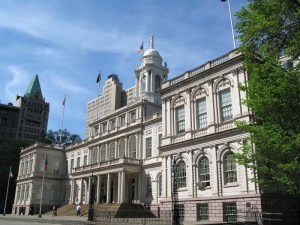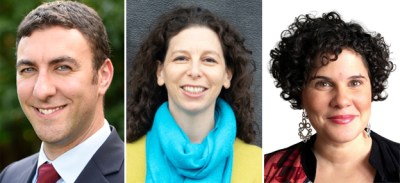DECISION 2021 — THE BRONX: Meet the Council Candidates for the Bronx District 15…

The vast majority of council members are term-limited and cannot run for re-election this year. But there are a number of special elections before the June 22, 2021 main event — and one of those is in District 15, which includes the Bronx neighborhoods of Allerton, Bathgate, Bedford Park, Belmont, East Tremont, Fordham, Mount Hope, Olinville, Van Nest, and West Farms (a seat previously represented by Ritchie Torres before he was promoted to the House of Representatives). The special election is on Tuesday, March 23, though early voting is underway. Streetsblog spoke with three of the 10 candidates vying to replace Torres — all of whom have qualified for matching public funds, according to the Campaign Finance Board. The fourth candidate who received matching funds, Oswald Feliz, did not respond.

Like District 11, it’s all about the bus in District 15, which otherwise lacks public transportation options to go east and west. The Cross Bronx Expressway runs through the southern section of the district as well, an environmental and transportation disaster dating back decades. And although part of the district is slated to be part of the Department of Transportation’s e-scooter share pilot program, the district also lacks protected bike lanes, leaving residents vulnerable to traffic violence if they want to get around without a car. Since January, 2019, there have been 6,564 crashes injuring 192 cyclists, 413 pedestrians (killing one), and injuring 1,607 motorists (killing two), according to Crash Mapper.
That’s more than eight crashes per day.
How will the candidates address that? We asked…
John Sanchez
- District Manager, Community Board 6
- Raised $204,843, spent $131,971
Asked about the transportation situation in District 15, Sanchez immediately focused on bus service as the key to moving people around.
“This is a place where the Cross Bronx Expressway tore through the neighborhood, where the Third Avenue, elevated train line was torn down,” he said. “So we inherit that legacy. Many of my neighbors and I, we live a 20-minute walk from the train in either direction. We rely on the buses. And right now, the bus service is slow and infrequent and unreliable. And the transportation policy in the 15th Council District really has to focus on reliable and frequent bus service.”
Fixing that bus service means adding a pair of busways, on Third Avenue and Fordham Road, a pair of bus priority projects that Sanchez called “big-ticket items.”
Sanchez, who won a StreetsPAC endorsement in this race, said that he’s never driven a car in his life, sounds ready to spend political capital on those improvements.
“I’m a district manager of a community board and I think it’s important for council members to appoint pro-transit, community board members, and that’s what I intend to do,” he said. “I really intend to utilize community boards in a different way, and be much more active in them in how they run. And at the end of the day, a board should not be able to veto traffic improvements in our city. In fact, they don’t have that veto power in our law right now. DOT should stop hiding behind that facade, and enable the mayor to use his power to control the streets, which he can do right now.”
Sanchez identified Grand Concourse and Crotona Avenue as areas in the district that he thought could benefit from bike lanes that have bollards, not just paint.
Outside of new busways and truly protected bike lanes, Sanchez said he wants to see the end of the Cross Bronx Expressway, a project he saw a way to create jobs and people-first streets at the same time.
“You could have housing, to have park space, you could have a busway. You could have bike lanes. Tearing down the Cross Bronx is an opportunity to create jobs, but so is also rebuilding what gets put there in its place. So it’s really an exciting opportunity.”
The candidate does have a compromise position for car owners, which is seeing their paid parking money being put directly towards neighborhood improvements. It’s a bit of an unconventional position, given that may studies show that the existence of parking is what contributes to more driving and more congestion, so let’s let Sanchez explain it in full:
I want to introduce legislation for parking benefit districts. There are some people that feel very strongly about having parking. And if you’re far from the train, it makes more sense to want parking. But if we’re going to have parking, we should have more parking meters. And if we’re going to have parking meters, the meter revenue should stay in the neighborhood for neighborhood improvements. I think that’s something people can get around, especially if say they’re on Fordham Road and the meter says the money you’re paying is going towards improving the sidewalks on Fordham Road. People may not like paying, but at least they can say, “OK, it’s benefiting the neighborhood.” I think that’s a fair compromise.
Elisa Crespo
- Education liaison at the Office of the Bronx Borough President
- Raised $185,606, spent $124,737
Crespo was blunt in her assessment of what it takes to make a people-first city.
“We can’t really create a pedestrian friendly city if you are not trying to eliminate the car culture,” she said. “Obviously, we’re going to have to address our car culture in our city, and do what we can to move away from that. In a district like mine, you have small pockets of communities that are car owners, but for the most part, people here get around using the subway and the bus. And so we cannot allow a small group of disgruntled neighbors to dictate what our city looks like going forward.”
What that city looks like in District 15 is a Fordham Road busway and parking protected bike lanes according to Crespo.
“Overall, I’m really focused on creating a connected bike network across our city, connecting existing routes, and ensuring that bike lanes are really been truly protected with actual physical posts. The ones that I particularly favor are the parking protected bike lanes that we see in other parts of our city. Those would be perfect for the service roads on each side of the Grand Concourse.”
Crespo also said she was excited about the upcoming e-scooter pilot eventually reaching the 15th District, and that it was imperative to work with street safety advocates to make sure that a new form of getting around didn’t lead to a new rash of injuries and fatalities.
“We have to create safe streets, because as we invest in e-scooters and we tell people to take different methods of transportation other than motor vehicles, it’s incumbent upon us to make sure that we’re creating an actual safe routes for them to get to places conveniently and quickly and without the fear of getting into a fatal situation.”
Crespo is also an advocate for ReThinkNYC’s Regional Unified Network, a transportation vision that if completed could connect the Bronx, Queens and New Jersey in a train network. Beyond giving Bronxites the ability to get to Queens by rail without going through Manhattan, Crespo said such a network could fit a world where Manhattan is no longer the sun around which the other boroughs orbit.
“In the future, as we look 10 to 20 years out from now, creating transportation hubs throughout the five boroughs is important. I would argue that we only really have one in the city in that sort of central business district of Manhattan. But what if we had that in every borough? How would that increase jobs and economic activity?”
Latchmi Gopal
- National Organizer on the Sanders 2020 campaign
- So far raised $95,661, spent $30,110
Gopal has a series of proposals that would no doubt eat into space for private cars in 15th District: superblocks, curbside trash storage, public plazas and protected bike lanes. It’s an ambitious set of goals and one that Gopal thinks she can accomplish by drawing on experience she’s racked up working on issues like Fair Fares.
“You cannot just decide transit policy without having intentional planning dialogue with community,” she said. “I watched the Riders Alliance really adjust and shift what they were bringing to the policy fight based on deep conversations with the community, multiple meetings and town halls asking what is needed in order to have your buses and your trains work better for you. And I think that model of collective group decision making, and really having a chance to strategize as a collective neighborhood or a collective community, is something that needs to be brought to City Council.”
Gopal insisted that her aim with group decision-making is not merely to empower the minority stakeholders: drivers.
“Prioritizing drivers can’t be the only thing. It really can’t. And there will be tension there, 100 percent. But I think the benefits of what we’re proposing are just so much larger and will have a significant impact on the community and individuals, so it’s worth it.”
Gopal said that she was a fan of the currently stalled Bronx bus network redesign, and that part of her job representing the Bronx would be ensure that the unrealized elements in that, and proposals like the Fast Forward plan and the Better Buses Plan, actually come to life.
“We have to make sure that we have digital information screens, that we’re able to increase bus speeds by 25 percent, and adding 10 to 15 miles of bus lanes. These things will have a tangible impact. And redesigning our buses ultimately is the more economically feasible idea in this moment, because you can move around buses easier than you can uproot train stations, or shift around train routes,” she said.
Gopal also said she had some eye-opening experiences riding her bike in the Bronx last year, which drove home the need to get the borough its share of protected bike lanes.
“I got a bike in April and I started riding, and our borough is just not conducive to it. I have to sometimes take the train with my bike somewhere before I can ride in a way that feels safe. Not only like physically safe because our streets aren’t set up for it, but also environmentally safe. Over here, you have areas where the bike lanes just abruptly cut off, and you’re not supposed to be on the sidewalks, but what feels safe? It’s not conducive, so we have to we have to figure out how to make sure our streets genuinely work for all of us and not just cars and drivers,” she said.

